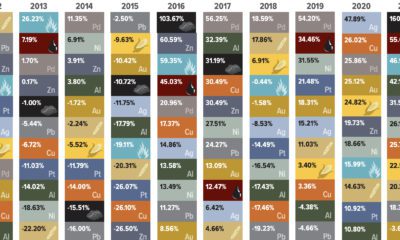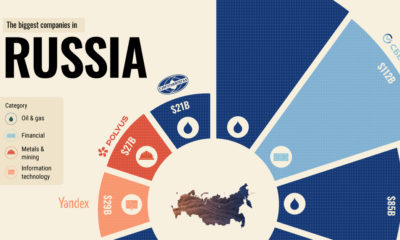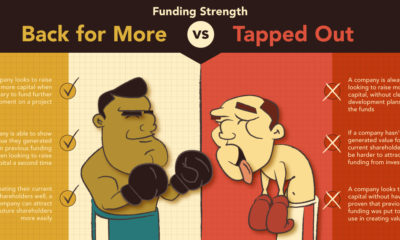However, even with today’s advancements – almost all early-stage prospecting methods are still based on the same key principle: trying to find areas of exposed bedrock, called outcrops, that indicate an orebody is near. But such outcrops only form in certain circumstances – and what happens when a geological system doesn’t come in contact directly with the surface?
The Problem of Cover
Today’s infographic comes to us from Nevada Exploration, and it identifies the problem behind finding these “hidden” deposits that do not leave a helpful trail of clues on the surface. Instead of having outcrops where rocks can be readily sampled, these deposits are trapped underneath large amounts of soil and gravel. Geologists call this a covered setting, where they must first find a way to “see through” the cover in order to identify what geological systems really exist below. Seeing through cover can be expensive and difficult to do, but it also has big potential upside. – Dr. Richard Goldfarb, Ph.D., United States Geologic Survey In fact, many geologists think that the next game-changing gold deposit could be found under cover.
Exploration 2.0
For explorers, it is no secret that the cost per discovery is going up dramatically over time. The reality is that traditional exploration methods are achieving diminishing returns, and as a result companies are settling for lower grade deposits, more complex geological settings, and politically questionable jurisdictions. Minex Consulting says that between 2007-2016, there has been $65 billion spent globally on gold exploration with only $30 billion worth of discoveries to show for it. Those aren’t exactly inspiring economics for future gold explorers. But for every industry problem, there is often a precedent to be found elsewhere – and an interesting situation that is analogous was faced by the oil exploration industry years ago. They had reached diminishing returns with shallow water deposits, and developed technology to go deeper. Suddenly, monster deposits were being found again. Experts involved in mineral exploration see the same thing happening with cover. – Cam McCuaig, Principal Geoscientist, BHP Billiton In other words: whoever can figure out how to explore under cover could be reaping big benefits.
The Prize
In the world’s most prolific gold jurisdictions, there are massive amounts of land that have not yet been explored because of cover. In Canada and in Australia, over 70% of land is covered. In Nevada, which produces the most gold ounces per square kilometer, about 55% of land is covered. Interestingly, Nevada has produced 225 million oz of gold to date, but the majority of these discoveries have come from outcrop clues on the surface. Imagine what gold could be hidden under soil and gravel within the valleys of the state. Global data so far suggests that deposits discovered under cover tend to be 2-4x bigger.
Exploring Under Cover
While the idea of unlocking this potential is extremely exciting, it also poses a significant technical challenge. Conventional tools are poorly suited to covered settings, and existing techniques for systematic exploration don’t work. The end result is high-risk, high-cost exploration. To successfully explore through cover, companies need:
New technology to see through cover A way to lower the costs of testing targets A way to directly test covered bedrock
So far, a few ideas have been pioneered for seeing through cover – and it will be interesting to see what results they bring in. Biogeochemistry: In Australia, explorers are using biogeochemistry as a hint to see what lays beneath the soil. Plants accumulate pathfinder elements in them, or even tiny amounts of gold, which allows explorers to get a hint at what lies deep below. Hydrogeochemistry: In a place like Nevada, there are massive valleys in the middle of prolific gold districts that have remained unexplored because they are covered with hundreds of meters of gravel. Testing groundwater might be the key, because groundwater flows by gravity from mountains to deep in the valley centers. On the way, this water interacts with bedrock – and any gold deposits that are hidden beneath the surface. Explorers are looking at other ideas as well, ranging from regional-scale mapping to adapting other oil and gas industry techniques. If any of them are able to unlock the secret of exploring through cover, it could be the catalyst for industrywide change, as well as the discovery of the monster deposits that will meet our mineral needs of the future. on Did you know that nearly one-fifth of all the gold ever mined is held by central banks? Besides investors and jewelry consumers, central banks are a major source of gold demand. In fact, in 2022, central banks snapped up gold at the fastest pace since 1967. However, the record gold purchases of 2022 are in stark contrast to the 1990s and early 2000s, when central banks were net sellers of gold. The above infographic uses data from the World Gold Council to show 30 years of central bank gold demand, highlighting how official attitudes toward gold have changed in the last 30 years.
Why Do Central Banks Buy Gold?
Gold plays an important role in the financial reserves of numerous nations. Here are three of the reasons why central banks hold gold:
Balancing foreign exchange reserves Central banks have long held gold as part of their reserves to manage risk from currency holdings and to promote stability during economic turmoil. Hedging against fiat currencies Gold offers a hedge against the eroding purchasing power of currencies (mainly the U.S. dollar) due to inflation. Diversifying portfolios Gold has an inverse correlation with the U.S. dollar. When the dollar falls in value, gold prices tend to rise, protecting central banks from volatility. The Switch from Selling to Buying In the 1990s and early 2000s, central banks were net sellers of gold. There were several reasons behind the selling, including good macroeconomic conditions and a downward trend in gold prices. Due to strong economic growth, gold’s safe-haven properties were less valuable, and low returns made it unattractive as an investment. Central bank attitudes toward gold started changing following the 1997 Asian financial crisis and then later, the 2007–08 financial crisis. Since 2010, central banks have been net buyers of gold on an annual basis. Here’s a look at the 10 largest official buyers of gold from the end of 1999 to end of 2021: Rank CountryAmount of Gold Bought (tonnes)% of All Buying #1🇷🇺 Russia 1,88828% #2🇨🇳 China 1,55223% #3🇹🇷 Türkiye 5418% #4🇮🇳 India 3956% #5🇰🇿 Kazakhstan 3455% #6🇺🇿 Uzbekistan 3115% #7🇸🇦 Saudi Arabia 1803% #8🇹🇭 Thailand 1682% #9🇵🇱 Poland1282% #10🇲🇽 Mexico 1152% Total5,62384% Source: IMF The top 10 official buyers of gold between end-1999 and end-2021 represent 84% of all the gold bought by central banks during this period. Russia and China—arguably the United States’ top geopolitical rivals—have been the largest gold buyers over the last two decades. Russia, in particular, accelerated its gold purchases after being hit by Western sanctions following its annexation of Crimea in 2014. Interestingly, the majority of nations on the above list are emerging economies. These countries have likely been stockpiling gold to hedge against financial and geopolitical risks affecting currencies, primarily the U.S. dollar. Meanwhile, European nations including Switzerland, France, Netherlands, and the UK were the largest sellers of gold between 1999 and 2021, under the Central Bank Gold Agreement (CBGA) framework. Which Central Banks Bought Gold in 2022? In 2022, central banks bought a record 1,136 tonnes of gold, worth around $70 billion. Country2022 Gold Purchases (tonnes)% of Total 🇹🇷 Türkiye14813% 🇨🇳 China 625% 🇪🇬 Egypt 474% 🇶🇦 Qatar333% 🇮🇶 Iraq 343% 🇮🇳 India 333% 🇦🇪 UAE 252% 🇰🇬 Kyrgyzstan 61% 🇹🇯 Tajikistan 40.4% 🇪🇨 Ecuador 30.3% 🌍 Unreported 74165% Total1,136100% Türkiye, experiencing 86% year-over-year inflation as of October 2022, was the largest buyer, adding 148 tonnes to its reserves. China continued its gold-buying spree with 62 tonnes added in the months of November and December, amid rising geopolitical tensions with the United States. Overall, emerging markets continued the trend that started in the 2000s, accounting for the bulk of gold purchases. Meanwhile, a significant two-thirds, or 741 tonnes of official gold purchases were unreported in 2022. According to analysts, unreported gold purchases are likely to have come from countries like China and Russia, who are looking to de-dollarize global trade to circumvent Western sanctions.
There were several reasons behind the selling, including good macroeconomic conditions and a downward trend in gold prices. Due to strong economic growth, gold’s safe-haven properties were less valuable, and low returns made it unattractive as an investment.
Central bank attitudes toward gold started changing following the 1997 Asian financial crisis and then later, the 2007–08 financial crisis. Since 2010, central banks have been net buyers of gold on an annual basis.
Here’s a look at the 10 largest official buyers of gold from the end of 1999 to end of 2021:
Source: IMF
The top 10 official buyers of gold between end-1999 and end-2021 represent 84% of all the gold bought by central banks during this period.
Russia and China—arguably the United States’ top geopolitical rivals—have been the largest gold buyers over the last two decades. Russia, in particular, accelerated its gold purchases after being hit by Western sanctions following its annexation of Crimea in 2014.
Interestingly, the majority of nations on the above list are emerging economies. These countries have likely been stockpiling gold to hedge against financial and geopolitical risks affecting currencies, primarily the U.S. dollar.
Meanwhile, European nations including Switzerland, France, Netherlands, and the UK were the largest sellers of gold between 1999 and 2021, under the Central Bank Gold Agreement (CBGA) framework.
Which Central Banks Bought Gold in 2022?
In 2022, central banks bought a record 1,136 tonnes of gold, worth around $70 billion. Türkiye, experiencing 86% year-over-year inflation as of October 2022, was the largest buyer, adding 148 tonnes to its reserves. China continued its gold-buying spree with 62 tonnes added in the months of November and December, amid rising geopolitical tensions with the United States. Overall, emerging markets continued the trend that started in the 2000s, accounting for the bulk of gold purchases. Meanwhile, a significant two-thirds, or 741 tonnes of official gold purchases were unreported in 2022. According to analysts, unreported gold purchases are likely to have come from countries like China and Russia, who are looking to de-dollarize global trade to circumvent Western sanctions.












